ISSN ONLINE(2319-8753)PRINT(2347-6710)
ISSN ONLINE(2319-8753)PRINT(2347-6710)
Mani A, Jothilingam A
|
| Related article at Pubmed, Scholar Google |
Visit for more related articles at International Journal of Innovative Research in Science, Engineering and Technology
This paper discusses the development and fabrication of a semi-autonomous tree climber and harvester (COCOBOT). Cocobot comprises of two mechanisms namely a climbing mechanism and a harvesting mechanism. The climbing mechanism consists of a octagon shaped chassis. Four active wheels are set at specific intervals around the tree of which one pair is for the upper side and the other for the lower side of the chassis. The main features of the climbing mechanism include the location of centre of mass of the cocobot outside the tree and the innovative climbing strategy fusing the straight and spiral climbs. The harvesting mechanism consists of an arm with three degree of freedom with a circular saw as an end effector. The bunch of nuts is located by a vision sensor (camera) which is placed at the wrist of the arm. The nuts are harvested using the saw based on the output received from the camera. The entire movement of the cocobot and the harvesting mechanism is controlled using remote controller.
Keywords |
| Coconut Harvesting, Tree climbing. |
INTRODUCTION |
| Coconut harvesting plays a very important role in the economy of many developing countries. Unfortunately despite its mass distribution and wide spread around the world, coconut harvesting is still done without proper safety measures which can lead to serious casualties. We have taken into account the safety, reliability, the ease of use which is capable of climbing trees, cutting down coconuts, cleaning the tree tops. Usually all over the country, farmers practice conventional harvesting method in which coconuts are picked by specially trained, skillful and experienced climbers. Knife sickle or iron hook attached to the plucking end of long bamboo poles are also used for picking nuts. Coconuts have to be plucked once every 45 days and those who own the trees are finding it increasingly difficult to find professional pickers. |
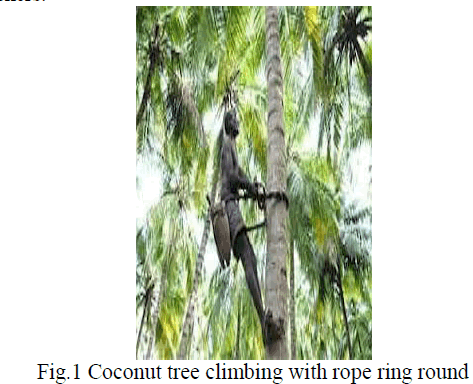 |
| Many young men now shun coconut-picking in favour of white collar jobs, meaning there is no longer a guaranteed labour force Coconut Tree climbers are a rarity these days in Kerala and other coconut growing states of Karnataka, Tamil Nadu, Andhra Pradesh, Maharashtra and Goa, with very few taking on the traditional profession. Coconut climbers are a very vital link in the production chain. The scarcity of labour disrupts harvesting cycle’s thus causing loss of income to the growers. As against the general norm of harvesting cycles of 45-60 days, farmers are currently able to harvest only once in three to four months. In some gardens in Kerala 2-3 meter long ladders are used for climbing coconut palms for harvesting nuts. It has been reported that a simple coconut palm climbing device has also been used by the climbers for harvesting nuts. |
| In the recent past there has been an array of coconut palm climbing devices developed by individuals, Research Institutions, Universities and NGO’s , which are claimed to be safe and easy to operate. But in spite of all the efforts taken in the recent past, there is still an acute shortage of trained coconut palm climbers for harvesting and plant protection activities. Now a days three types of harvesting methods are held with the human. These methods are, Human Climbing, Power tiller operated ladder, Climbing cycle / equipment. |
CLIMBING MECHANISM |
| The main features of the climbing mechanism include the location of centre of mass of the cocobat outside of the tree like Indian coconut tree climbing method by human as shown in Fig. 1. A principle of the developed climbing method is explained by a two dimensional models shown in Fig.2 |
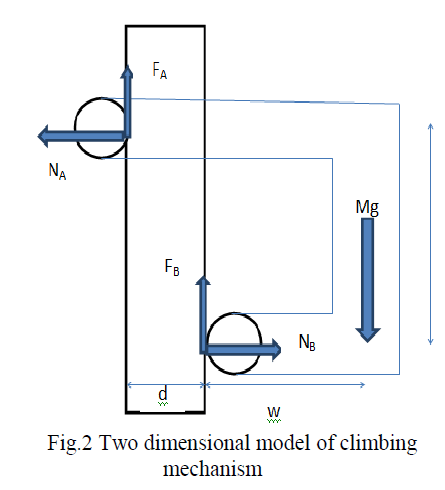 |
| Then the equilibrium of force are given by in the x direction, |
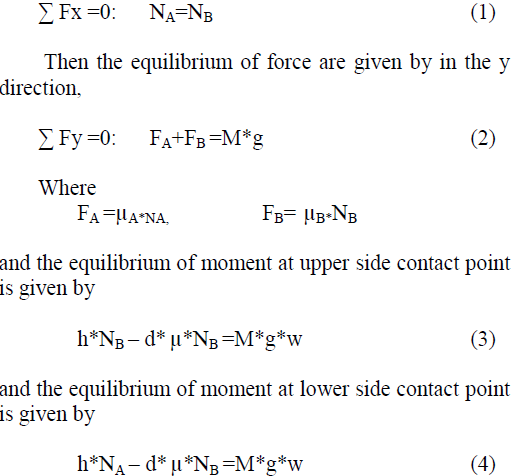 |
| where μA and μB friction coefficients, M is a mass of the robot, g is gravity due to acceleration, NA and NB are normal constraint forces at the contact points between wheels and a tree, h is a length between upper and lower wheels, d is a diameter of tree, and w is a length from the surface of tree to the center of mass of the cocobot. FAand FB are the frictional forces at the contact points between wheels and a tree. If μA=μB=μ , then we get |
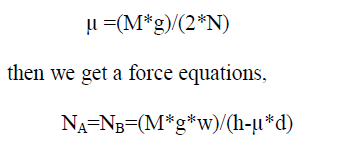 |
| The climbing mechanism consists of a octagon shaped chassis. Four active wheels are set at specific intervals around the tree of which one pair is for the upper side and the other for the lower side of the chassis. Each active wheel is driven by a DC motor through a worm gear that has no back drivability. The innovative climbing strategy fusing the straight and spiral climbs is used in this model. The spiral climbing has the four dc motor attached to this. Aluminum is used for fabrication because of its light weight. The CAD model of the setup is shown in Fig 3. |
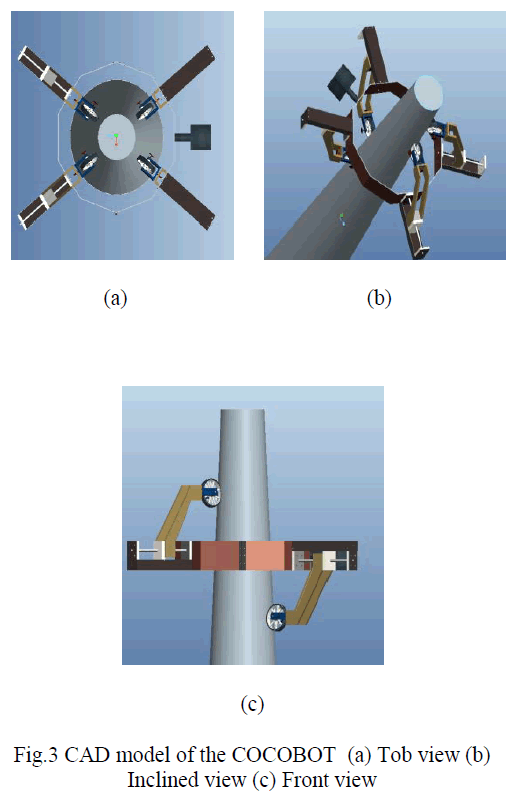 |
HARVESTING MECHANISM |
| The harvesting mechanism consists of an arm with three degree of freedom with a circular saw as an end effector. The bunch of nuts is located by a vision sensor (camera) which is placed at the wrist of the arm. The nuts are harvested using the saw based on the output received from the camera. The entire movement of the cocobot and the harvesting mechanism is controlled using a radio frequency based remote controller. The CAD model of the cocobot is shown in Fig 4. |
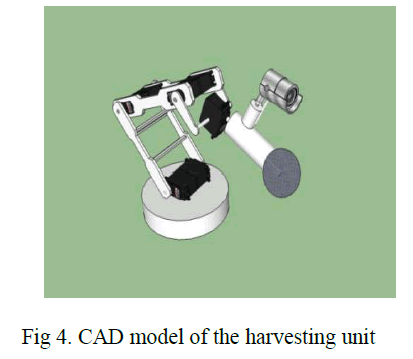 |
WORKING PRINCIPLE |
| Cocobot locates a centre of mass at outside of tree and uses where to climb vertically. The wheel mechanism is designed for a hybrid climbing method. The robot is able to switch between strait and spiral climbs. This method ensures both lightweight and high climbing speed feature in the cocobot. The velocity of the straight climb is the first target that is controlled by this human like controller. The harvesting mechanism consists of an arm with three degree of freedom with a circular saw as end effectors. The bunch of nuts is located by a vision sensor (camera) which is placed at the wrist of the arm. The nuts are harvested using the saw based on the output received from the camera. The entire movement of the cocobot and the harvesting mechanism is controlled using a radio frequency based remote controller. The developed cocobot climbing setup is shown in Fig 5. |
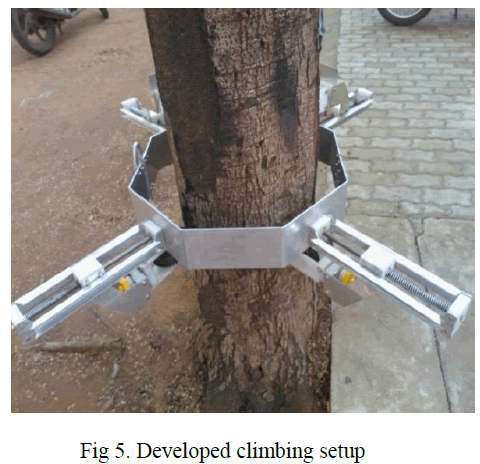 |
CONTROL UNIT |
| Two separate controllers are used for controlling the climbing and harvesting process. The climbing unit consists of four DC motors that are coupled to the wheels through worm gear wheel mechanism. The controlling signals are sent to the motors through the motor drivers by a microcontroller. IR sensors are used to detect the presence of obstacle during climbing. The harvesting unit consists of four unipolar stepper motors to manipulate the arm and to harvest the coconut. Harvester is controlled manually from ground location. The position of the coconut can be viewed by a wireless camera. The control of the Cocobot is shown in Fig 6. And the remote control unit is shown in Fig 7. |
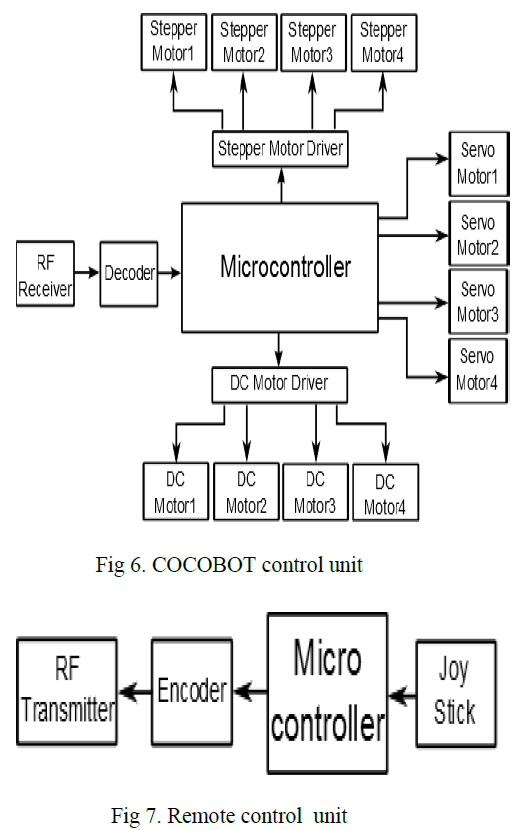 |
CONCLUSION |
| In this study, a novel method for coconut climbing and harvesting is proposed. The design of the hardware setup is discussed and the controlling units are designed. Wireless camera is used to find the exact position of the coconut. Thus a semi automatic Cocobot model is designed. |
References |
|